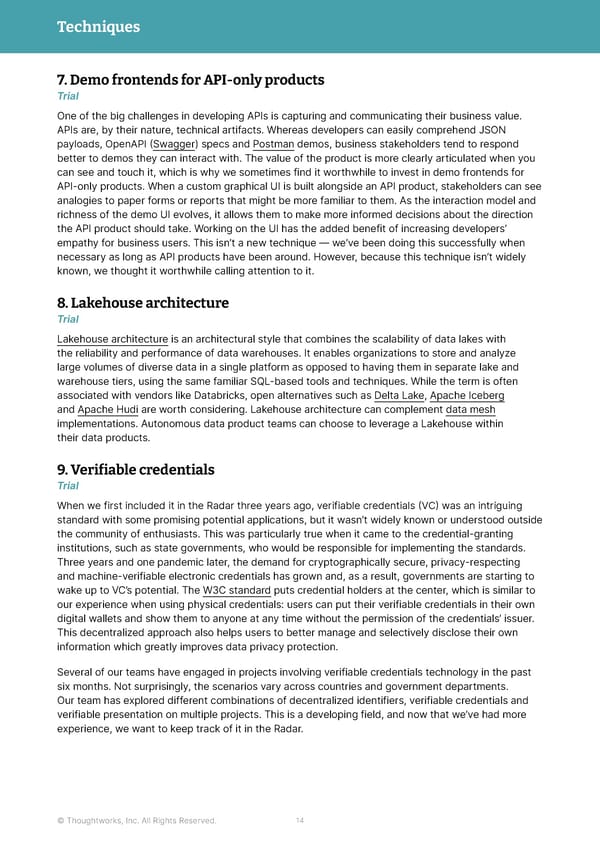Techniques 7. Demo frontends for API-only products Trial One of the big challenges in developing APIs is capturing and communicating their business value. APIs are, by their nature, technical artifacts. Whereas developers can easily comprehend JSON payloads, OpenAPI (Swagger) specs and Postman demos, business stakeholders tend to respond better to demos they can interact with. The value of the product is more clearly articulated when you can see and touch it, which is why we sometimes find it worthwhile to invest in demo frontends for API-only products. When a custom graphical UI is built alongside an API product, stakeholders can see analogies to paper forms or reports that might be more familiar to them. As the interaction model and richness of the demo UI evolves, it allows them to make more informed decisions about the direction the API product should take. Working on the UI has the added benefit of increasing developers’ empathy for business users. This isn’t a new technique — we’ve been doing this successfully when necessary as long as API products have been around. However, because this technique isn’t widely known, we thought it worthwhile calling attention to it. 8. Lakehouse architecture Trial Lakehouse architecture is an architectural style that combines the scalability of data lakes with the reliability and performance of data warehouses. It enables organizations to store and analyze large volumes of diverse data in a single platform as opposed to having them in separate lake and warehouse tiers, using the same familiar SQL-based tools and techniques. While the term is often associated with vendors like Databricks, open alternatives such as Delta Lake, Apache Iceberg and Apache Hudi are worth considering. Lakehouse architecture can complement data mesh implementations. Autonomous data product teams can choose to leverage a Lakehouse within their data products. 9. Verifiable credentials Trial When we first included it in the Radar three years ago, verifiable credentials (VC) was an intriguing standard with some promising potential applications, but it wasn’t widely known or understood outside the community of enthusiasts. This was particularly true when it came to the credential-granting institutions, such as state governments, who would be responsible for implementing the standards. Three years and one pandemic later, the demand for cryptographically secure, privacy-respecting and machine-verifiable electronic credentials has grown and, as a result, governments are starting to wake up to VC’s potential. The W3C standard puts credential holders at the center, which is similar to our experience when using physical credentials: users can put their verifiable credentials in their own digital wallets and show them to anyone at any time without the permission of the credentials’ issuer. This decentralized approach also helps users to better manage and selectively disclose their own information which greatly improves data privacy protection. Several of our teams have engaged in projects involving verifiable credentials technology in the past six months. Not surprisingly, the scenarios vary across countries and government departments. Our team has explored different combinations of decentralized identifiers, verifiable credentials and verifiable presentation on multiple projects. This is a developing field, and now that we’ve had more experience, we want to keep track of it in the Radar. © Thoughtworks, Inc. All Rights Reserved. 14
 Immersive Experience — Vol 28 | Thoughtworks Technology Radar Page 13 Page 15
Immersive Experience — Vol 28 | Thoughtworks Technology Radar Page 13 Page 15